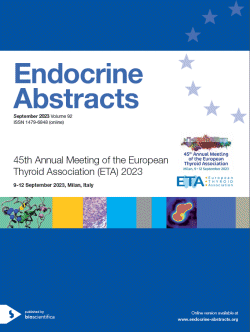
45th Annual Meeting of the European Thyroid Association (ETA) 2023
Poster Presentations
Hyperthyroidism
ea0092ps2-15-01 | Hyperthyroidism | ETA2023
A prospective, observational study on the effect of an ablative vs a conservative approach for the treatment of graves’ hyperthyroidism in patients with moderate-to-severe, active graves’ orbitopathy
Cosentino Giada , Lanzolla Giulia , Comi Simone , Menconi Francesca , Rotondo Dottore Giovanna , Novella Maglionico Maria , Posarelli Chiara , Figus Michele , Elisei Rossella , Santini Ferruccio , Marino Michele
ea0092ps2-15-02 | Hyperthyroidism | ETA2023
Grip strength in newly diagnosed hyperthyroidism
Tosheva Gergana , Siderova Mira
ea0092ps2-15-03 | Hyperthyroidism | ETA2023
Does iodine fortification affect the risk of atrial fibrillation in incident hyperthyroidism?
Tang Moellehave Line , Knudsen Nils , Prescott Eva , Bulow Pedersen Inge , Ravn-Haren Gitte , Linneberg Allan
ea0092ps2-15-04 | Hyperthyroidism | ETA2023
THY-PRO 39 questionnaire in graves` disease patients after therapy
Villagelin Danilo , Perini Nicolas , Santos Roberto , Romaldini Joao
ea0092ps2-15-05 | Hyperthyroidism | ETA2023
Resting heart rate monitoring for optimized treatment of hyperthyroidism - the pulsar-study
Baumann Carole , Teubler Aline , Betz Matthias , Maushart Claudia
ea0092ps2-15-06 | Hyperthyroidism | ETA2023
Factors influencing early outcome of radioiodine treatment in patients with graves’ disease
Pirnat Edvard , Zaletel Tjaša , Rot Živa , Gaberscek Simona , Zaletel Katja
ea0092ps2-15-07 | Hyperthyroidism | ETA2023
Immunogenetics markers of graves’ disease relapse after antithyroid treatment
Zhilina Ekaterina , Drogashevskaya Natalia , Martirosian Narine , Petunina Nina
ea0092ps2-15-08 | Hyperthyroidism | ETA2023
Extended pharmacometrics computer model utilizes heart rate to monitor thyroid function in adults with graves’ disease under carbimazole monotherapy
Steffens Britta , Koch Gilbert , Pfister Marc , Zuger Noemi , Bachmann Freya , Schropp Johannes , Johannes Betz Matthias , Szinnai Gabor
ea0092ps2-15-09 | Hyperthyroidism | ETA2023
Long-term follow-up after antithyroid drug treatment withdrawal in patients with the first episode of graves` disease: a retrospective cohort study in spain
Meneses Diego , Sanchez Lechuga Begona , Velez Romero Maria , Sierra Poyatos Roberto , Vazquez Martinez Clotilde , Cardenas Salas Jersy



